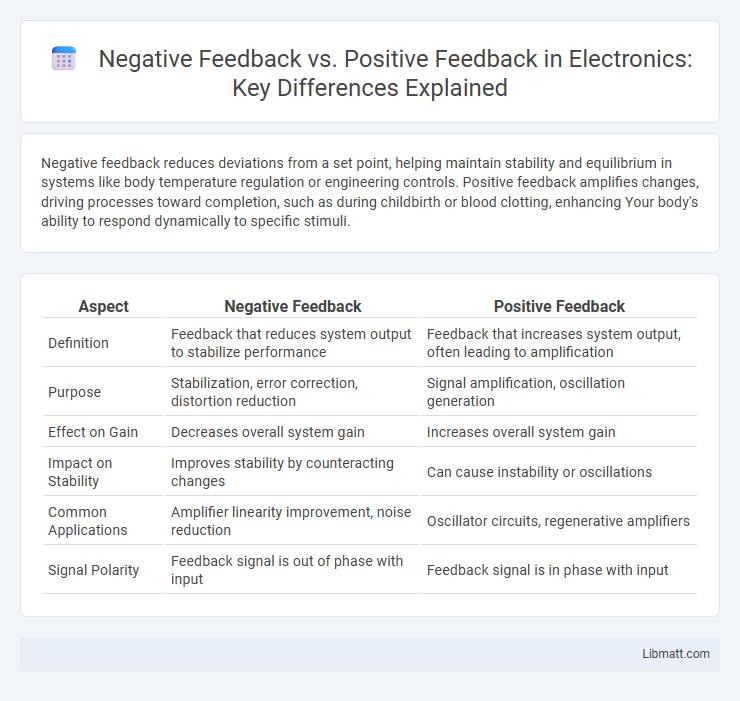Negative feedback reduces deviations from a set point, helping maintain stability and equilibrium in systems like body temperature regulation or engineering controls. Positive feedback amplifies changes, driving processes toward completion, such as during childbirth or blood clotting, enhancing Your body's ability to respond dynamically to specific stimuli.
Table of Comparison
| Aspect | Negative Feedback | Positive Feedback |
|---|---|---|
| Definition | Feedback that reduces system output to stabilize performance | Feedback that increases system output, often leading to amplification |
| Purpose | Stabilization, error correction, distortion reduction | Signal amplification, oscillation generation |
| Effect on Gain | Decreases overall system gain | Increases overall system gain |
| Impact on Stability | Improves stability by counteracting changes | Can cause instability or oscillations |
| Common Applications | Amplifier linearity improvement, noise reduction | Oscillator circuits, regenerative amplifiers |
| Signal Polarity | Feedback signal is out of phase with input | Feedback signal is in phase with input |
Introduction to Feedback Mechanisms
Feedback mechanisms regulate system stability and change through opposing processes. Negative feedback reduces deviations from a set point by counteracting changes, maintaining equilibrium in biological, mechanical, and electronic systems. Positive feedback amplifies changes, driving systems toward a specific outcome or rapid transformation, essential in processes like blood clotting and childbirth.
Defining Negative Feedback
Negative feedback is a regulatory mechanism in biological systems where an increase in the output of a process inhibits its own production, maintaining homeostasis. It reduces deviations from a set point by reversing changes, such as the regulation of body temperature or blood glucose levels. This feedback loop ensures system stability and prevents overreaction to stimuli.
Defining Positive Feedback
Positive feedback amplifies changes in a system by reinforcing the direction of the initial stimulus, leading to exponential growth or acceleration within biological, electronic, or environmental systems. This mechanism is crucial in processes such as blood clotting, nerve signal transmission, and population dynamics, where rapid response amplification is necessary. Unlike negative feedback, which stabilizes systems by counteracting deviations, positive feedback drives systems toward increased output or change, often resulting in a self-perpetuating cycle.
Key Differences Between Negative and Positive Feedback
Negative feedback reduces deviations from a set point, promoting system stability and homeostasis, while positive feedback amplifies changes, driving processes toward a specific outcome. Negative feedback loops are common in biological systems, such as temperature regulation and blood glucose control, whereas positive feedback mechanisms are seen in processes like blood clotting and childbirth contractions. Understanding these key differences helps you recognize how feedback systems maintain balance or accelerate responses in various contexts.
Biological Examples of Negative Feedback
Negative feedback mechanisms in biology regulate processes such as body temperature control by the hypothalamus and blood glucose levels managed by insulin and glucagon. The homeostasis of blood pressure involves baroreceptors detecting changes and triggering responses to maintain stability through vasodilation or vasoconstriction. These examples illustrate how negative feedback loops maintain internal balance by counteracting deviations from set physiological conditions.
Biological Examples of Positive Feedback
Positive feedback amplifies biological processes, exemplified by the rapid release of oxytocin during childbirth, which intensifies uterine contractions until delivery occurs. Another example is the blood clotting cascade, where activated platelets release chemicals that accelerate further platelet activation at the injury site. Lactation also demonstrates positive feedback as the suckling stimulus triggers oxytocin release, enhancing milk ejection to nourish the infant.
Applications in Engineering and Technology
Negative feedback is widely used in engineering to stabilize systems, improve accuracy, and reduce distortion in applications such as amplifiers, control systems, and electronic circuits. Positive feedback finds critical roles in oscillators, regenerative circuits, and signal generators where it amplifies signals and sustains oscillations. Both feedback mechanisms are essential for optimizing performance and functionality in control engineering, robotics, and communication technologies.
Psychological Impact of Feedback Types
Negative feedback often triggers stress and defensiveness, hindering motivation and self-esteem, whereas positive feedback enhances confidence and encourages growth by reinforcing desired behaviors. Your brain responds to positive feedback with dopamine release, promoting learning and resilience, while negative feedback can activate the amygdala, heightening anxiety and avoidance. Balancing both types effectively supports emotional well-being and sustained personal development.
Advantages and Disadvantages of Each Feedback
Negative feedback enhances system stability and accuracy by counteracting deviations, reducing errors and preventing runaway effects, but it may slow response times and can lead to system oscillations if not properly tuned. Positive feedback amplifies system outputs, enabling rapid transitions and signal enhancement, beneficial in processes like amplification or regenerative circuits, yet it risks causing instability, saturation, and uncontrolled exponential growth. Understanding these trade-offs is crucial for designing efficient control systems that balance responsiveness with stability.
Choosing the Right Feedback Mechanism
Selecting the appropriate feedback mechanism depends on the desired stability and adaptability of the system; negative feedback is ideal for maintaining equilibrium by counteracting deviations, while positive feedback amplifies changes, promoting rapid adjustments or growth. In control systems and biological processes, negative feedback loops ensure homeostasis and error correction, whereas positive feedback loops accelerate processes like childbirth or action potentials. Evaluating system goals, response speed, and robustness guides the choice between negative and positive feedback, optimizing functionality and preventing instability.
Negative Feedback vs Positive Feedback Infographic

 libmatt.com
libmatt.com